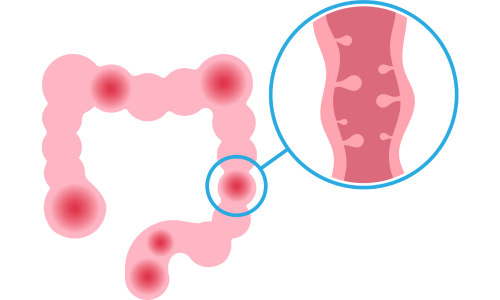
COLONIC DIVERTICULAR DISEASE: PREVENTION, TREATMENT & THE ROLE OF PROBIOTICS
DIVERTICULAR ABDOMINAL PAIN
Diverticular pain and diverticulitis refer to the presence of diverticula, small pouch-like projections that extend from the colon lining to its outer wall. This condition affects about 5% of Western adults under 40, rising to 50% in those over 50 and 75% in individuals over 60.
The geographic variation and strong correlation with Western dietary habits suggest that diet plays a role, though the exact cause remains unclear. One theory is that diverticula form when increased pressure in the colon, often due to constipation, causes the bowel wall to bulge at weak spots.
DIVERTICULITIS
Around 10–25% of people with diverticular disease experience inflamed or infected diverticula. Diverticulitis is often diagnosed based on symptoms like severe abdominal pain, bloating, nausea, or fever. Complications may include fistulas, intestinal obstruction, lower gastrointestinal bleeding, or perforated diverticula leading to abscesses.
PREVENTION
Fiber and fluids help soften stools, enabling easier passage through the colon and reducing pressure on the intestinal walls. A balanced, high-fiber diet and adequate hydration offer numerous health benefits beyond diverticular disease prevention.
STANDARD TREATMENT
Mild diverticulitis cases are typically managed on an outpatient basis with a high-fiber or liquid diet, rest, and 7–10 days of broad-spectrum antibiotics. Severe cases may require hospitalization for intravenous nutrition to rest the bowels.
HERBAL TREATMENTS
In a small retrospective study involving 31 patients with diverticulitis, those treated with daiobotanpito, a traditional Japanese herbal medicine (Kampo), along with intravenous antibiotics experienced reduced fever, less abdominal pain, and shorter antibiotic courses compared to those receiving only antibiotics.
SURGICAL TREATMENT
Only about 1% of patients require surgery, where the affected segment of the bowel is removed, and healthy segments are reconnected.
ROLE OF PROBIOTICS
Probiotics are live microorganisms that can modify the host microbiota and confer health benefits without increasing antibiotic resistance. For example, Lactobacillus acidophilus is considered a “good bacterium” that aids nutrient absorption, food breakdown, and protection against pathogens.
Probiotic Benefits for Diverticulitis
Although specific probiotic data for diverticular disease is limited, some studies highlight the potential benefits of probiotics for gut health, including:
- Anti-inflammatory effects that balance gut microbiota.
- Enhanced defense against infections by maintaining appropriate bacterial colonization.
- Inhibition of harmful bacterial growth.
- Metabolizing and eliminating pathogens.
Probiotics may help restore healthy microbial levels or return the body to normal after illness, positively influencing the immune response.
Butyrate: A Postbiotic Metabolite
Butyrate is a short-chain fatty acid produced by gut bacteria fermenting carbohydrates. It serves as a primary energy source for colon cells.
-
Benefits of Butyrate:
- Enhances gut permeability and anti-inflammatory properties.
- Prevents gastrointestinal conditions like chronic inflammatory bowel disease, diverticulitis, and IBS.
-
Butyrate and Diverticulitis:
Clinical studies show sodium butyrate supplementation significantly reduces diverticulitis episodes and improves quality of life. Combining probiotics (e.g., Bifidobacterium lactis, Lactobacillus acidophilus, and Lactobacillus sardius) with antibiotics has shown promise in reducing abdominal pain and inflammation.
CONCLUSION
Ongoing high-quality research is needed to evaluate whether antibiotics remain essential in managing uncomplicated diverticulitis. Preliminary findings suggest promising roles for preventive treatments like butyrate or probiotics. Meanwhile, organizations such as the Digestive Disease Association continue to monitor emerging studies on this common yet concerning condition.
References:
Repenser le traitement et la prévention de la diverticulite
